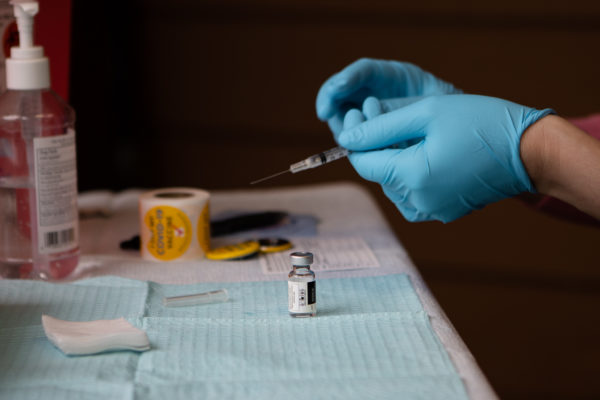
Alaska has returned to a statewide high alert level as the number of COVID-19 infections and hospitalizations climb while the vaccination rate has stalled.
“This pandemic is clearly not over, and it is being driven primarily by people who are unvaccinated,” said Dr. Joe McLaughlin, Alaska’s state epidemiologist.
The latest increase in cases started around early July, and rose steeply last week, said McLaughlin. It has prompted some communities, like Juneau, to ask people to mask up indoors again, whether they’re vaccinated or not.
Across the country, many states are seeing an uptick in new coronavirus cases, after a plunge in infections earlier this year.
According to state data, Alaska tallied 882 new infections last week — up 140% from the week before, but still lower than the winter surge. The vast majority of new cases involve people who aren’t vaccinated, said McLaughlin.
He said there are two big factors driving the latest wave of infections.
First, there’s rise of the highly-contagious delta variant, which now accounts for most of the new cases in Alaska. Second, he said, the state has reopened and more people are together in-person again.
“So the more that people congregate, the more transmission is going to happen, especially when you’ve got this delta variant circulating,” McLaughlin said.
RELATED: Delta variant wasn’t detected in Alaska until a few weeks ago. Now it’s 40% of samples.
The good news is that Alaskans who are fully vaccinated are largely protected from the coronavirus, including the delta variant, said McLaughlin. But the problem is that Alaska’s vaccinations have slowed: Just 52% of residents age 12 and up are fully vaccinated.
“Our proportion of the population that is getting vaccinated now is much, much lower than it was a couple of months ago,” said McLaughlin. “And we really need to see that change.”
Along with the recent rise in cases, Alaska’s hospitals are also reporting an increase in patients with serious symptoms from the virus.
According to state data, 59 people were hospitalized with the coronavirus in Alaska on Saturday, up from 37 a week earlier.
[Sign up for Alaska Public Media’s daily newsletter to get our top stories delivered to your inbox.]
At the Alaska Native Medical Center in Anchorage, the increase in coronavirus patients started in early July, said Dr. Holly Alfrey, chief medical officer.
“Roughly two weeks ago, we maybe had two inpatients for coronavirus. And this morning, we were up to 14,” she said.
Alfrey said all of the patients the hospital has admitted for coronavirus symptoms have not been vaccinated.
“As a physician, I will tell you that I think that the reason people are getting sick and getting in the hospital is because they haven’t been vaccinated,” she said. “I think it’s stretching us significantly — at our hospital and all hospitals in Anchorage and actually hospitals nationwide.”
Nearby, at Alaska Regional Hospital, Infection Prevention Coordinator Jenny Mayo said the number of patients with COVID-19 has also steadily increased over the past two weeks.
“The majority of these patients are either not vaccinated, or not fully vaccinated,” she said. “The overall number of hospitalizations has not yet reached the levels of previous waves, but the increasing numbers of COVID-19 is concerning.”
Mayo said most of the patients are younger — under age 65 — compared to earlier spikes.
While the hospital does see a few patients who have tested positive for the coronavirus despite being fully vaccinated, she said, “these individuals are more likely to have milder or moderate symptoms.”
Mayo, Alfrey and McLaughlin urged Alaskans to get vaccinated against COVID-19.
Vaccination rates vary widely between communities, and McLaughlin said he worries regions with lower rates will become hot spots.
“I suspect that we’re just going to continue to see increases with this new delta variant,” he said. “The communities that have the lower vaccination rates are going to be the communities that are likely to be hit harder by this uptick in cases and likely to see more outbreaks.”
If you are not vaccinated, McLaughlin advised wearing a face mask when around people outside of your immediate social bubble. Also, wearing a mask in crowded public settings could be a good idea for vaccinated Alaskans who want added protection, he said, including those with underlying medical conditions.
Reach reporter Tegan Hanlon at thanlon@alaskapublic.org or 907-550-8447.
Tegan Hanlon is the digital managing editor at Alaska Public Media. Reach her at thanlon@alaskapublic.org or 907-550-8447. Read more about Tegan here.





